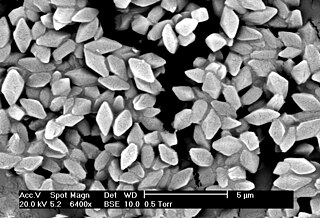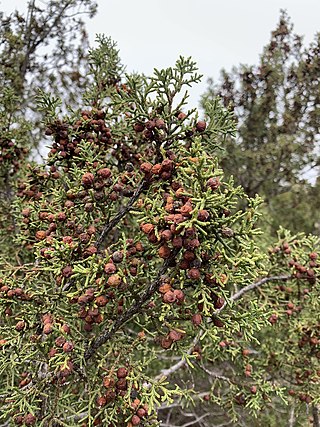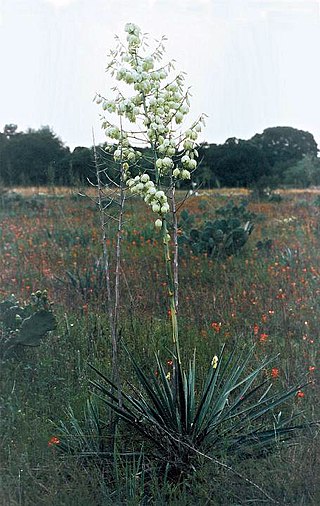
Bacillus thuringiensis is a gram-positive, soil-dwelling bacterium, the most commonly used biological pesticide worldwide. B. thuringiensis also occurs naturally in the gut of caterpillars of various types of moths and butterflies, as well on leaf surfaces, aquatic environments, animal feces, insect-rich environments, and flour mills and grain-storage facilities. It has also been observed to parasitize moths such as Cadra calidella—in laboratory experiments working with C. calidella, many of the moths were diseased due to this parasite.

Bacillus is a genus of Gram-positive, rod-shaped bacteria, a member of the phylum Bacillota, with 266 named species. The term is also used to describe the shape (rod) of other so-shaped bacteria; and the plural Bacilli is the name of the class of bacteria to which this genus belongs. Bacillus species can be either obligate aerobes which are dependent on oxygen, or facultative anaerobes which can survive in the absence of oxygen. Cultured Bacillus species test positive for the enzyme catalase if oxygen has been used or is present.

Gaillardia is a genus of flowering plants in the family Asteraceae, native to North and South America. It was named after Maître Gaillard de Charentonneau, an 18th-century French magistrate who was an enthusiastic botanist. The common name may refer to the resemblance of the inflorescence to the brightly patterned blankets made by Native Americans, or to the ability of wild taxa to blanket the ground with colonies. Many cultivars have been bred for ornamental use.

Cuatro Ciénegas is a city in the northern Mexican state of Coahuila. It stands at 26°59′N102°03′W, at an average elevation of 740 metres (2,430 ft) above sea level. The city serves as the municipal seat for the surrounding municipality of the same name.

Muzquizopteryx is a genus of nyctosaurid pterodactyloid pterosaur from the Late Cretaceous period of what is now Coahuila, Mexico.
Juniperus coahuilensis, commonly known as redberry juniper, is a species of conifer in the family Cupressaceae.

Juniperus pinchotii, commonly known as Pinchot juniper or redberry juniper, is a species of juniper native to south-western North America, in Mexico: Nuevo León and Coahuila, and in the United States: south-eastern New Mexico, central Texas, and western Oklahoma.
Quercus coahuilensis is a species of plant in the family Fagaceae. It is endemic to the Mexican state of Coahuila. It is placed in section Lobatae.

Velafrons is a genus of lambeosaurine hadrosaurid dinosaur from the Late Cretaceous of Mexico. It is known from a mostly complete skull and partial skeleton of a juvenile individual, with a bony crest on the forehead. Its fossils were found in the late Campanian-age Cerro del Pueblo Formation, near Rincon Colorado, Coahuila, Mexico. The type specimen is CPC-59, and the type species is V. coahuilensis.

The Cerro del Pueblo Formation is a geological formation in Coahuila, Mexico whose strata date back to the Late Cretaceous. Dinosaur remains are among the fossils that have been recovered from the formation. The formation is believed to correlate with the Baculites reesidesi and Baculites jenseni ammonite zones, which dates it to 73.63-72.74 Ma.

Salvia coahuilensis is a perennial shrub native to the Sierra Madre Oriental in the Mexican state of Coahuila. It is a low-growing evergreen, under 2.5 ft in height and width, with many woody branches growing from the base. It has 1 in long beet-purple flowers, and 1 in long widely spaced, linear olive-green leaves.
Phanerostylis is a genus of Mexican plants in the tribe Eupatorieae within the family Asteraceae.
Mycobacterium lepromatosis is an aerobic, acid-fast bacillus (AFB), and the second known causative agent of Hansen's disease (leprosy). It was discovered in 2008. Analysis of the 16S rRNA gene confirms that the species is distinct from Mycobacterium leprae.

Ratibida is a genus of North American plants in the tribe Heliantheae within the family Asteraceae. Members of the genus are commonly known as prairie coneflowers or mexican-hat.

Nyctosauridae is a family of specialized soaring pterosaurs of the late Cretaceous Period of North America, Africa, and possibly Europe. It was named in 1889 by Henry Alleyne Nicholson and Richard Lydekker.

Magnapaulia is a genus of herbivorous lambeosaurine hadrosaurid dinosaurs known from the Latest Cretaceous Baja California, of northwestern Mexico. It contains a single species, Magnapaulia laticaudus. Magnapaulia was first described in 1981 as a possible species of Lambeosaurus by William J. Morris, and was given its own genus in 2012 by Prieto-Márquez and colleagues.

Yucca coahuilensis is a plant in the family Asparagaceae, native to grasslands of southern Texas and northern Coahuila. It has a basal rosette of stiff, very narrow leaves, and an inflorescence up to 2.5 m tall, bearing creamy white flowers.
Gaillardia coahuilensis, the bandanna daisy, is a North American species of flowering plant in the sunflower family. It is native to northwestern Mexico (Coahuila) and the southwestern United States.
Sabinosuchus is a genus of Mesoeucrocodylian, from the Maastrichtian Escondido Formation of Coahuila, Mexico, with Sabinosuchus coahuilensis as the type species. First described as a putative dyrosaurid by Shiller II et al. (2016), it was later recovered as a pholidosaurid by Jouve & Jalil (2020).
Pseudomonas cuatrocienegasensis is a Gram-negative, non-spore-forming and rod-shaped bacterium from the genus of Pseudomonas.












